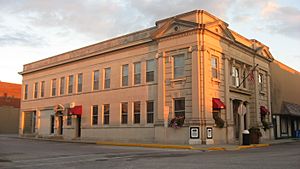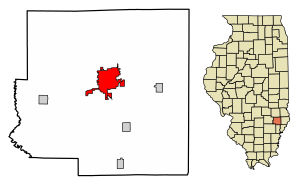Olney, Illinois facts for kids
Quick facts for kids
Olney
|
|||
|---|---|---|---|

Front and northern side of the former Olney CNB Bank, located at 202 S. Whittle Street in Olney
|
|||
|
|||
| Motto(s):
"Home of the White Squirrel"
|
|||

Location of Olney in Richland County, Illinois
|
|||

Location of Illinois in the United States
|
|||
| Country | United States | ||
| State | Illinois | ||
| County | Richland | ||
| Founded | 1848 | ||
| Area | |||
| • Total | 6.93 sq mi (17.95 km2) | ||
| • Land | 6.93 sq mi (17.95 km2) | ||
| • Water | 0.00 sq mi (0.00 km2) | ||
| Elevation | 489 ft (149 m) | ||
| Population
(2020)
|
|||
| • Total | 8,701 | ||
| • Density | 1,255.37/sq mi (484.70/km2) | ||
| Time zone | UTC-6 (CST) | ||
| • Summer (DST) | UTC-5 (CDT) | ||
| ZIP Code(s) |
62450
|
||
| Area code(s) | 618 | ||
| FIPS code | 17–55912 | ||
| GNIS feature ID | 2396060 | ||
| Wikimedia Commons | Olney, Illinois | ||
Olney (/ˈɔːlni/ AWL-nee) is a city in Richland County, Illinois. It is the main city, also known as the county seat, of Richland County. In 2010, about 9,115 people lived there.
Contents
History of Olney
People started settling in the Richland County area around 1815. A man named Thaddeus Morehouse built a log cabin. This cabin was a hotel and a place for travelers to stop. It was located on a road that went from Vincennes, Indiana, to St. Louis.
Richland County was officially created in 1841. It was formed from parts of Clay and Lawrence counties. There was a discussion about where the main city, or county seat, should be. Olney was chosen because someone donated land, and it was in the center of the county. Judge Aaron Shaw suggested the name "Olney" to honor his friend, Nathan Olney. The town officially became a village in 1848.
The Civil War caused some trouble in the county. Some people supported the Union, and others supported the Confederacy. Most citizens in Olney supported the Union. About 1,700 people from Richland County fought for the Union in the Civil War.
Later, nearly 1,000 Olney residents served in World War I. During World War II, Richland County was special. It might have been the only county in Illinois (besides Cook County) that provided four generals for the war effort.
The first count of people in Richland County was in 1850. At that time, 4,012 people lived there. One hundred years later, in 1950, a spot near Dundas, north of Olney, was found to be the population center of the United States. This means it was the average location of all people in the country.
Geography and Climate
Olney is located at 38°44′N 88°5′W / 38.733°N 88.083°W.
According to the 2010 census, Olney covers about 6.66 square miles (17.26 square kilometers) of land. Only a tiny part is water.
Olney's Climate
Olney has a climate with warm summers and cold winters. The weather changes throughout the year, bringing different temperatures and amounts of rain or snow.
| Climate data for Olney 2S, Illinois (1991–2020 normals, extremes 1896–present) | |||||||||||||
|---|---|---|---|---|---|---|---|---|---|---|---|---|---|
| Month | Jan | Feb | Mar | Apr | May | Jun | Jul | Aug | Sep | Oct | Nov | Dec | Year |
| Record high °F (°C) | 75 (24) |
78 (26) |
89 (32) |
91 (33) |
98 (37) |
106 (41) |
112 (44) |
109 (43) |
106 (41) |
97 (36) |
83 (28) |
74 (23) |
112 (44) |
| Mean daily maximum °F (°C) | 37.8 (3.2) |
42.7 (5.9) |
53.4 (11.9) |
65.6 (18.7) |
75.1 (23.9) |
84.1 (28.9) |
86.8 (30.4) |
85.8 (29.9) |
80.4 (26.9) |
68.5 (20.3) |
53.9 (12.2) |
42.3 (5.7) |
64.7 (18.2) |
| Daily mean °F (°C) | 29.3 (−1.5) |
33.3 (0.7) |
42.9 (6.1) |
54.2 (12.3) |
64.2 (17.9) |
73.2 (22.9) |
76.2 (24.6) |
74.8 (23.8) |
68.1 (20.1) |
56.4 (13.6) |
43.7 (6.5) |
34.0 (1.1) |
54.2 (12.3) |
| Mean daily minimum °F (°C) | 20.8 (−6.2) |
23.9 (−4.5) |
32.3 (0.2) |
42.7 (5.9) |
53.3 (11.8) |
62.4 (16.9) |
65.6 (18.7) |
63.8 (17.7) |
55.8 (13.2) |
44.3 (6.8) |
33.5 (0.8) |
25.7 (−3.5) |
43.7 (6.5) |
| Record low °F (°C) | −24 (−31) |
−25 (−32) |
−15 (−26) |
21 (−6) |
29 (−2) |
36 (2) |
45 (7) |
41 (5) |
27 (−3) |
17 (−8) |
−2 (−19) |
−19 (−28) |
−25 (−32) |
| Average precipitation inches (mm) | 3.52 (89) |
2.57 (65) |
4.21 (107) |
5.02 (128) |
5.60 (142) |
4.79 (122) |
4.96 (126) |
3.19 (81) |
3.31 (84) |
3.83 (97) |
4.26 (108) |
3.50 (89) |
48.76 (1,239) |
| Average snowfall inches (cm) | 3.6 (9.1) |
2.6 (6.6) |
1.1 (2.8) |
0.0 (0.0) |
0.0 (0.0) |
0.0 (0.0) |
0.0 (0.0) |
0.0 (0.0) |
0.0 (0.0) |
0.0 (0.0) |
0.5 (1.3) |
2.7 (6.9) |
10.5 (27) |
| Average precipitation days (≥ 0.01 in) | 10.6 | 8.7 | 11.8 | 11.2 | 12.7 | 10.5 | 9.2 | 8.1 | 7.7 | 9.1 | 9.6 | 10.9 | 120.1 |
| Average snowy days (≥ 0.1 in) | 2.9 | 2.1 | 0.7 | 0.0 | 0.0 | 0.0 | 0.0 | 0.0 | 0.0 | 0.0 | 0.4 | 1.9 | 8.0 |
| Source: NOAA | |||||||||||||
Olney's Population
| Historical population | |||
|---|---|---|---|
| Census | Pop. | %± | |
| 1860 | 1,435 | — | |
| 1870 | 2,680 | 86.8% | |
| 1880 | 3,512 | 31.0% | |
| 1890 | 3,831 | 9.1% | |
| 1900 | 4,260 | 11.2% | |
| 1910 | 5,011 | 17.6% | |
| 1920 | 4,491 | −10.4% | |
| 1930 | 6,140 | 36.7% | |
| 1940 | 7,831 | 27.5% | |
| 1950 | 8,612 | 10.0% | |
| 1960 | 8,780 | 2.0% | |
| 1970 | 8,974 | 2.2% | |
| 1980 | 9,026 | 0.6% | |
| 1990 | 8,664 | −4.0% | |
| 2000 | 8,631 | −0.4% | |
| 2010 | 9,115 | 5.6% | |
| 2020 | 8,701 | −4.5% | |
| U.S. Decennial Census | |||
In 2000, there were 8,631 people living in Olney. These people lived in 3,755 households. About 28% of these households had children under 18. The average age of people in Olney was 39 years old.
Education in Olney
Olney has several schools for students of all ages.
Colleges and Universities
- Olney Central College
Public Schools
- Richland County High School
- Richland County Middle School
Private Schools
- St. Joesph Catholic School Pre-K to 8th Grade
- Full Armor Christian School Pre-K to 8th Grade
Famous People from Olney
Many interesting people have connections to Olney. Here are a few:
- Terry L. Bruce: He was a state senator and a United States congressman.
- Glenn Brummer: He played baseball as a catcher for the St. Louis Cardinals and Texas Rangers.
- Reginald C. Harmon: He was the first judge advocate general for the U.S. Air Force.
- James R. Lindsay: He was a brigadier general in the U.S. Army.
- Butch Lockley: He was a reality television personality from the show Survivor: The Amazon.
- Herbert Murphy: He played baseball as a shortstop for the Philadelphia Phillies.
- Ollie Pickering: He was an outfielder for six different Major League Baseball teams.
- Stan Royer: He played baseball as an infielder for the Boston Red Sox and St. Louis Cardinals.
- Elaine Shepard: She was an actress.
Media in Olney
Olney has its own local newspaper and a TV station.
- The Olney Gazette is a weekly newspaper that started in 2017.
- WUSI-TV (Channel 16) is a public television station. It is part of PBS and is run by Southern Illinois University.
See also
 In Spanish: Olney (Illinois) para niños
In Spanish: Olney (Illinois) para niños




